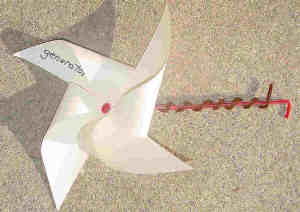BACKGROUND:
If a bulb "lights up,"
electricity is flowing through the wires in a closed circuit. If the
bulb doesn't light up, electricity isn't flowing and it is an open
circuit. Electricity can be generated by water (hydroelectric),
batteries (chemical) or nuclear. Remember, electricity is a flow of
electrons - it doesn't matter which "electrons" or what causes
the energy that moves the electrons.
Electricity is all around us, but we
rarely think about it. Students don't question where electricity comes
from when a switch is turned on and off and many may not know where
electricity originates. Many large cities get their power from
hydroelectric sources. In the early 1900's, there was a
"master" plan to develop and trap energy by damming water. The
water would then move large turbines of a generator that could be converted to
electricity. Generators have huge coils and giant magnets.
Generators can use water, wind, or other types of energy to move the
giant magnets. The spinning magnet generates electrons and
the coils capture them and creates current electricity. This electricity would then move to the cities by a network
of wires.
The history of electricity is
fascinating, especially because many of the early pioneers became
famous. Prior to 1880's there was no public supply of power, even in
advanced countries of the world. Sources had to be close and voltage had
to be low because all that was first available was direct current. As
the demands and distances of customers increased, alternating current
was used because of its greater transmission through the use of
transformers. It was slowly realized that electrical power was a common
commodity and many public power stations started to develop a network to
help generate a continuous source of power.
The first public DC power was in
London in early 1882. The second was in New York in late 1882 and was
started by Thomas Edison. In 1886, Westinghouse and Stanley created the
first alternating current in Massachusetts. Students may be familiar
with the Edison and Westinghouse companies that bear these early
inventors names.
PROCEDURE:
- Use the worksheet and see if
students can visualize how these power plants carry electricity for all
people to use. You may want to use this as an overhead and trace how
electricity travels to an urban area.
-
 Students can use this diagram
to try and find out who supplies power in your city. Ask them to discuss
this with their parents or guardians to try and find the name. Make sure
students realize that they pay for electricity that comes into their
house. Have them identify whether they use electricity or gas at their
home. Many home use both, some are all electricity.
Students can use this diagram
to try and find out who supplies power in your city. Ask them to discuss
this with their parents or guardians to try and find the name. Make sure
students realize that they pay for electricity that comes into their
house. Have them identify whether they use electricity or gas at their
home. Many home use both, some are all electricity.
-
Generating electricity is difficult to understand.
Building a model generator helps students to understand the basic
concepts. Students need to make a cut out the pin wheel on the enclosed
sheet. The pin wheel represents the turbines of a generator. Sew one of
the pipe cleaners in the center of the pin wheel and push it through the
straw. This would represent the turning magnet. Coil another
pin wheel around the straw, which represents the metal coils that would pick
up electrons from the spinning magnet. As the pin wheel turns it
spins the magnet which produces electrons, that travel along the coil to be
used by people.